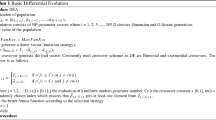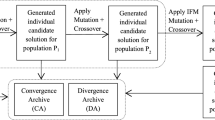Abstract
The problem in software cost estimation revolves around accuracy. To improve the accuracy, heuristic/meta-heuristic algorithms have been known to yield better results when it is applied in the domain of software cost estimation. For the sake of accuracy in results, we are still modifying these algorithms. Here we have proposed a new meta-heuristic algorithm based on Differential Evolution (DE) by Homeostasis mutation operator. Software development requires high prediction and low Root Mean Squared Error (RMSE) and mean magnitude relative error(MMRE). The problem in software cost estimation relates to accurate prediction and minimization of RMSE and MMRE, which are used to solve multiobjective optimization. Many versions of DE were proposed, however multi-objective versions where the concept of Pareto optimality is used, are most popular. Pareto-Based Differential Evolution (PBDE) is one of them. Although the performance of this algorithm is very good, its convergence rate can be further improved by minimizing the time complexity of nondominated sorting, and by improving the diversity of solutions. This has been implemented by using efficient nondominated algorithm whose time complexity is better than the previous one and a new mutation scheme is implemented in DE which can provide more diversity among solutions. The proposed variant multiplies the Homeostasis value with one more vector, named the Homeostasis mutation vector, in the existing mutation vector to provide more bandwidth for selecting effective mutant solutions. The proposed approach provides more promising solutions to guide the evolution and helps DE escape the situation of stagnation. The performance of the proposed algorithm is evaluated on twelve benchmark test functions (bi-objective and tri-objective) on the Pareto-optimal front. The performance of the proposed algorithm is compared with other state-of-the-art algorithms on five multi-objective evolutionary algorithms (MOEAs). The result verifies that our proposed Homeostasis mutation strategy performs better than other state-of-the-art algorithms. Finally, application of MODE-HBM is applied to solve in terms of Pareto front, representing the trade-off between development RMSE, MMRE, and prediction for COCOMO model.












Similar content being viewed by others
Explore related subjects
Discover the latest articles, news and stories from top researchers in related subjects.References
Abbass HA, Sarker R, Newton C (2001) PDE: a Pareto-frontier differential evolution approach for multi-objective optimization problems. In: Proceedings of the congress on evolutionary computation 2001 (CEC2001), vol 2, pp 971–978
Abbass HA (2002) The self-adaptive Pareto differential evolution. In: Proceedings of the congress on evolutionary computation 2002 (CEC2002), vol 1, pp 831–836
Abbass HA (2001) A memetic pareto evolutionary approach to artificial neural networks. In: Advances in artificial intelligence, AI 2001. Springer, Berlin Heidelberg, pp 1–12
Chang CS, Xu DY, Quek HB (1999) Pareto-optimal set based multiobjective tuning of fuzzy automatic train operation for mass transit system. IEE Proc Electric Power Appl 146(5). IET
Babu BV, Mathew Leenus Jehan M (2003) Differential evolution for multi-objective optimization. In: Proceedings of the 2003 congress on evolutionary computation (CEC’2003), vol 4. IEEE Press, Canberra, Australia, pp 2696–2703
Li H, Zhang Q (2006) A multiobjective differential evolution based on decomposition for multiobjective optimization with variable linkages. In: Parallel problem solving from nature-PPSN IX. Springer, Berlin Heidelberg, pp 583–592
Kukkonen S, Lampinen J (2004) An extension of generalized differential evolution for multi-objective optimization with constraints, Parallel Problem Solving from Nature-PPSN VIII. Springer, Berlin Heidelberg
Kukkonen S, Lampinen J (2005) GDE3: the third evolution step of generalized differential evolution, 2005. In: The 2005 IEEE congress on evolutionary computation, vol 1. IEEE
Flores EAP (2006) Integracion Simultanea de Aspectos Estructurales y Dinamicos para el Diseno Optimo de un Sistema de Transmission de Variacian Continua. Diss. PhD thesis, Departamento de Ingenieria Electrica, Seccion de Mecatronica, CINVESTAV-IPN, Mexico
Bo-yang QU, Suganthan P-N (2010) Multi-objective differential evolution with diversity enhancement. Zhejiang Univ-Sci C (Comput Electron) 2010 11(7):538–543
Wang YNx, Wu L-H, Yuan X-F (2010) Multi-objective self-adaptive differential evolution with elitist archive and crowding entropy-based diversity measure. Soft Comput 14:193–209
Angira R, Babu BV (2005) Non-dominated sorting differential evolution (NSDE): An Extension of Differential Evolution for Multi-objective Optimization, IICAI
Li K, Fialho A, Kwong S (2011) Multi-objective differential evolution with adaptive control of parameters and operators: Learning and Intelligent Optimization. Springer, Berlin Heidelberg , pp 473–487
Zhang Q, Li H (2007) MOEA/D: A multiobjective evolutionary algorithm based on decomposition. IEEE Trans Evol Comput 11.6:712–731
Li H, Zhang Q (2009) Multi-objective optimization problems with complicated Pareto sets, MOEA/D and NSGA-II. IEEE Trans Evol Comput 13(2):284–302
Tan YY, Jiao YC, Li H, Wang XK (2012) A modification to MOEA/D-DE for multiobjective optimization problems with complicated Pareto sets. Inf Sci 213:14–38
Robic T, Filipic B (2005) DEMO: differential evolution for multiobjective optimization. In: Proceedings of the 3rd international conference on evolutionary multicriterion optimization (EMO 2005), LNCS 3410, pp 520–533
Adeyemo JA, Otieno FAO (2009) Multi-objective differential evolution for solving engineering problems. J Appl Sci 9(20):3652–3661
Qian W, Li A (2008) Adaptive differential evolution algorithm for multiobjective optimization problems. Appl Math Comput 201:431–440
Xue F, Sanderson AC, Graves RJ (2003) Paretobased multi-objective differential evolution. In: The 2003 congress on evolutionary computation 2003. CEC’03 , vol 2. IEEE
Chen B, Lin Y, Zeng W, Zhang D, Si Y-W (2015) Modified differential evolution algorithm using a new diversity maintenance strategy for multi-objective optimization problems. Appl Intell 43(1):49–73. Harvard
Shi Q, Chen W, Jiang T, Shen D, Gao S (2015) Handling multiobjectives with adaptive mutation based 𝜖-dominance differential evolution. In: ICSI-CCI 2015, Part I, LNCS 9140, pp 523–532
Ali M, Pant M, Abraham A (2009) A modified differential evolution algorithm and its application to engineering problems. In: Proceedings of international conference of soft computing and pattern recognition (SoCPaR-2009), pp 196–201
Ali M, Siarry P, Pant M (2012) An efficient differential evolution based algorithm for solving multi-objective optimization problems. Eur J Oper Res 217(2):404–416
Chen X, Du W, Qian F (2014) Multi-objective differential evolution with ranking-based mutation operator and its application in chemical process optimization. Chemometr Intell Labor Syst 136:85–96
Zhang X, Tian Y, Cheng R, Jin Y (2015) An efficient approach to nondominated sorting for evolutionary multiobjective optimization. IEEE Trans Evol Comput 19(2):201–13
Deb K, Pratap A, Agarwal S, Meyarivan T, fast A (2002) algorithm, elitist multi-objective genetic: NSGA-II. IEEE Trans Evol Comput 6(2):182–197
Storn R, Price K (1997) Differential evolution - A simple and efficient heuristic for global optimization over continuous spaces. J Glob Optim 11(4):341–359
Bader J, Zitzler E (2008) HypE: an algorithm for fast hyper volume-based manyobjective optimization TIK Report 286. Computer Engineering and Networks Laboratory (TIK), ETH Zurich
Deb LT, Laumanns M, Zitzler E (2002) Scalable multi-objective optimization test problems. In: Proceedings of the congress on evolutionary computation (CEC-2002), Honolulu, USA, pp 825–830
Deb K, Thiele L, Laumanns M et al (2001) Scalable test problems for evolutionary multi-objective optimization. Technical report, Computer Engineering and Networks Lab (TIK), ETH Zurich, Switzerland
Schaffer JD (1985) Multiple objective optimization with vector evaluated genetic algorithm. In: Proceedings of the first international conference on genetic algorithms, pp 93–100
Rainer S, Price K (1995) Differential evolution-a simple and efficient adaptive scheme for global optimization over continuous spaces. International Computer Science Institute, Berkeley, CA
Van Veldhuizen DA, Lamont GB (1998) Multiobjective evolutionary algorithm research: a history and analysis Technical report, Department of Electrical and Computer Engineering. Graduate School of Engineering, Air Force Institute and Technology, Wright Patterson
Veldhuizen DA, Van Lamont GB (2000) On measuring multiobjective evolutionary algorithm performance. In: Proceedings of the congress on evolutionary computation 2000 (CEC’2000), vol 1, pp 204–211
Zitzler E, Thiele L (1999) Multiobjective evolutionary algorithms: a comparative case study and the strength Pareto approach. IEEE Trans Evol Comput 3(4):257–271
Zitzler E, Thiele L, Laumanns M, Fonseca CM, Da Fonseca VG (2003) Performance assessment of multiobjective optimizers: An analysis and review. IEEE Trans Evol Comput 7(2):117–13
Zitzler E, Deb K, Thiele L (2000) Comparison of multiobjective evolutionary algorithms: Empirical results. Evol Comput 8(2):173–195
Hasanluo M, Gharehchopogh FS (2016) Software cost estimation by a new hybrid model of particle swarm optimization and k-nearest neighbor algorithms. J Electr Comput Eng Innov JECEI 4(1):49–55
Santana Quintero LV, Coello Coello CA (2008) Development of techniques to improve computational efficiency in multi-objective evolutionary algorithms. Thesis submit in Centro De Investigation Y De Estudious Avanzados Del Instituto Politecnico Nactional Departamento De Computation, Mexico
Schott JR (1995) Fault tolerant design using single and multicriteria genetic algorithm optimization. Technical report, DTIC Document
Leung M-F, Ng S-C, Cheung C-C, Lui AK (2015) A new algorithm based on PSO for multi-objective optimization. In: IEEE congress on evolutionary computation (CEC)
Ke L, Zhang Q, Kwong S, Li M, Wang R (2014) Stable matching-based selection in evolutionary multiobjective optimization. IEEE Trans Evol Comput 18(6):909–923
Kumari S, Pushkar S (2013) Performance analysis of the software cost estimation methods: A Review. Int J Adv Res Comput Sci Softw Eng 3(7):229–238. ISSN: 2277 128X
The Standish Group Interaction, EXTREME CHAOS Report 2001
Sheta AF (2006) Estimation of the COCOMO model parameters using genetic algorithms for NASA software projects. J Comput Sci 2(2):118–123
Kumari S, Pushkar S (2013) Comparison and analysis of different software cost estimation methods. Int J Adv Comput Sci Appl 4(1):153–157
Prasad Reddy PVGD (2010) Particle swarm optimization in the fine-tuning of fuzzy software cost estimation models. Int J Softw Eng (IJSE) 1(2):12–23
Huang S-J, Chiu N-H (2007) Applying fuzzy neural network to estimate software development effort. Appl Intell Springer Sci+Bus Media 30(2):73–83. LLC
Lalwani S, Singhal S, Kumar R, Gupta N (2013) A comprehensive survey: Applications of multi-objective particle swarm optimizations (MOPSO) algorithm. Trans Comb 2(1):39–101
Dolado JJ, Andez LF (1998) Genetic programming, neural network and linear regression in software project estimation. In: Proceedings of the INSPIRE III, process improvement through training and education. British Company Society, British, pp 157–171
Aljahdali S, Sheta AF (2010) Software effort estimation by tuning COOCMO model parameters using differential evolution. In: ACS/IEEE international conference on computer systems and applications-AICCSA 2010, pp 1–6
Sheta AF, Aljahdali S (2013) Software effort estimation inspired by COCOMO and FP models: a fuzzy logic approach. Int J Adv Comput Sci Appl 11:4
Hari CHVMK, Prasad Reddy PVGD (2011) A fine parameter tunning for COCOMO 81 software effort estimation using particle swarm optimization. J Softw Eng 5(1):38–48
Boehm B (1981) Software engineering economics. Prentice-Hall, Englewood Cliffs, NJ
Boehm B (1995) Cost models for future software life cycle process: COCOMO2 Annals of Software Engineering
Boehm B et al (2000) Software cost estimation with COCOMO II. Prentice Hall PTR
Benediktsson O, Dalcher D, Reed K, Woodman M (2003) COCOMO based effort estimation for iterative and incremental software development. Softw Qual J 11:265–281
NASA Data SET: Project 63: http://promise.site.uottawa.ca/SERepository/datasets/cocomo81.arff
Dave VS, Dutta K (2012) Neural network based models for software effort estimation: a review. Artif Intell Rev 42: 295–307
Lin J-C, Tzeng H-Y (2010) Applying particle swarm optimization to estimate software effort by multiple factors software project clustering. In: 2010 international computer symposium (ICS), pp 1039–1044
Minku LL, Yao X (2013) Software effort estimation as a multi-objective learning problem. ACM Trans Softw Eng Methodol (TOSEM) 22(4)
Author information
Authors and Affiliations
Corresponding author
Rights and permissions
About this article
Cite this article
Singh, S.P., Kumar, A. Multiobjective differential evolution using homeostasis based mutation for application in software cost estimation. Appl Intell 48, 628–650 (2018). https://doi.org/10.1007/s10489-017-0980-6
Published:
Issue Date:
DOI: https://doi.org/10.1007/s10489-017-0980-6




